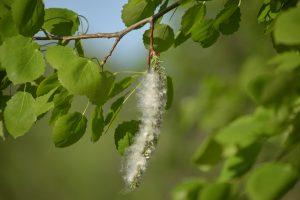
Dark times for the black poplar
In this article, we explore the black poplar which, according to the Forestry Commission, is the most endangered native timber tree in Britain.
A venerable tree
A large, spreading tree when fully mature, the black poplar takes its name from its grey-brown bark that, as it ages, often appears black. The gnarled trunk is covered with distinctive burrs and tuberous growths and the bark is deeply fissured giving the tree a venerable air. It can live for up to 200 years! .A native of the British Isles, the black poplar prefers heavy soil and damp conditions and is surprisingly tolerant of pollution, leading to it sometimes being planted in cities.
Once popular for building wooden-framed houses, black poplar timber is less flammable than most and the shock-resistant wood was also used to make carts and floorboards. Fine textured, the wood is soft and almost white in colour and, due to its ability to absorb paraffin, was also used to make matches. The Victorians favoured it for making clothes pegs, and black poplar timber was also traditionally used to make some artificial limbs, wine cases, pallets, shelving, toys and even clogs.
Known in northern England as the ‘Manchester poplar’, the tree featured heavily in the paintings of eastern England by legendary artist John Constable. Now chiefly to be found in Shropshire, Cheshire, Somerset and East Anglia, some have been planted in the Heart of England Forest along watercourses, primarily around Spernal, in a bid to arrest their declining numbers.
Decline and fall
Now officially rarer in numbers than the giant panda, the reasons for its decline are several. The last 200 years saw native black poplar replaced as a working timber tree by fast growing hybrids imported from abroad, and the decrease in its use severely reduced the need to plant it. Native trees also hybridise easily with non-native imports. This, combined with the black poplar requiring specific conditions to reproduce naturally, has led to a sharp reduction in its numbers. The black poplar has separate male and female trees. The female black poplar trees produce copious, downy seeds which were often seen as a nuisance, and they were consequently often destroyed and seldom planted. A popular food plant among the caterpillars of many moth species, including the hornet, wood leopard and poplar hawk, black poplar catkins also supply a valuable source of pollen and nectar for bees and other insects, while the seeds are eaten by birds.
With a natural balance of male and female trees required to ensure the survival of the species, the lack of female black poplars (of the 7,000 or so black poplar trees left in the UK there are thought to be as few as 600 females) leaves the tree unable to reproduce.
Across the UK, wildlife and conservation organisations, including the Heart of England Forest, are making a concerted effort to save this tree species, and without the lifesaving efforts of these groups the future for a native tree that has served society and the countryside ecosystems so admirably for generations remains sadly uncertain.
Help us ensure the future of native tree species
Join the Heart of England Forest in the fight to ensure the future of Britain’s indispensable native tree species.



